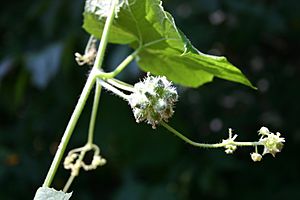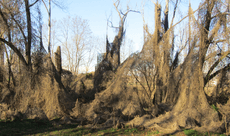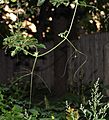Oneseed bur cucumber facts for kids
Quick facts for kids Oneseed bur cucumber |
|
|---|---|
 |
|
| Fruit and flowers | |
| Scientific classification | |
| Genus: |
Sicyos
|
| Species: |
angulatus
|
The Sicyos angulatus, also known as the oneseed bur cucumber or star-cucumber, is a type of annual vine. It belongs to the gourd family, Cucurbitaceae, which also includes pumpkins and watermelons. This plant is originally from eastern North America. It grows by forming thick mats or by climbing up other plants and structures using special curly parts called tendrils. Its leaves have a hand-like shape with several lobes, and its flowers are green to yellowish-green. The fruits grow in small groups and are like tiny, spiky berries.
Contents
What the Oneseed Bur Cucumber Looks Like
This vine grows long, branching stems each year. These stems can climb over shrubs and fences or spread out across the ground. The stems are usually hairy, light green, and have grooves. The leaves grow one after another along the stem. They have three to five lobes, like fingers on a hand, and can be up to 20 cm (8 inches) wide. The edges of the leaves are slightly jagged. The top side of the leaf is usually smooth, while the underside has fine hairs, especially on the veins.
The leaf is attached to the stem by a thick, hairy stalk called a petiole, which can be about 13 cm (5 inches) long. Where the petiole meets the stem, you might see branched tendrils or flower shoots.
Flowers and Fruits
The plant has both male and female flowers on the same plant, which is called monoecious. The male flowers grow on long stalks in groups called racemes. Each male flower is about 0.8 cm (0.3 inches) wide. It has five pointed teeth around its base (the calyx) and a whitish, green-veined flower (the corolla) with five lobes. In the center are the stamens, which produce pollen.
The small female flowers grow in bunches on a short stalk. Each female flower has its ovary inside a spiny, hairy fruit. Only one seed grows from each flower. The fruit is about 1.3 cm (0.5 inches) long. It starts green but turns brown as it gets older. Animals help spread the seeds when they touch the fruit's prickly surface and carry them away.
Where It Grows and Lives
The Sicyos angulatus is native to Ontario and Quebec in Canada. In the United States, it grows in the eastern and southern parts, reaching as far west as North Dakota and Texas. It likes to grow in rich, wet places. You can often find it in areas like floodplains, damp grasslands, thickets, and along river banks, ditches, and the edges of fields. It also grows well in ground that has been disturbed, like construction sites or recently cleared areas.
An Invasive Plant

In Europe, the oneseed bur cucumber was brought over in the 1700s as a plant to make gardens look nice. It was first reported growing wild in Germany in 1835. In Italy, it was found in Trentino by 1853.
Today, Sicyos angulatus is known as an invasive species. This means it spreads quickly and can harm local plants and ecosystems. It's hard to control because its seeds can stay alive in the ground for at least three years, even after the plant above ground is gone. When it spreads, it can form very thick and heavy mats that cover and smother other plants. This plant tends to spread along river banks, where it finds the best conditions to grow. However, you can also find it growing along roadsides and field edges.
How It Interacts with Other Living Things
Many insects are attracted to the sweet liquid called nectar produced by the flowers of Sicyos angulatus. These visitors include Bumblebees, honey bees, different types of flies, and various wasps. Some bees also collect pollen from the male flowers.
Certain insects, like the horned squash bug, Anasa repetita, the spotted cucumber beetle, the striped cucumber beetle, and the leaf beetle Acalymma gouldi, feed on this plant. However, larger plant-eating animals, like deer or rabbits, seem to avoid eating it.
Uses of the Plant
The leaves of Sicyos angulatus can be cooked and eaten as a green vegetable. The fruits can also be eaten, but they are very small, so they don't provide much food.
Gallery
See also
 In Spanish: Sicyos angulatus para niños
In Spanish: Sicyos angulatus para niños





